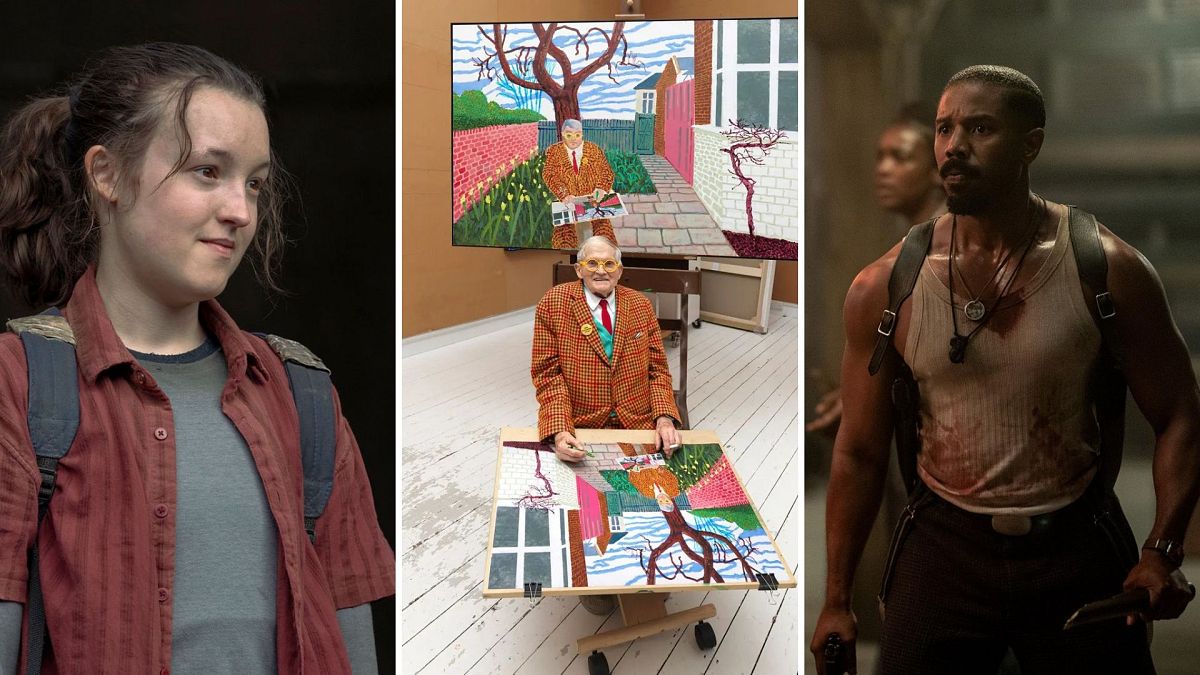This article includes a review of LA Almazara, followed by an interview with French designer and architect Phillip Starck.
In the middle of a lush, green olive farm in southern Spain looms what appears to be a giant red cube.
LA Almazara is an olive oil mill designed by Philippe Starck on the outskirts of Ronda, a city in Andalusia famous for its dramatic cliffside setting.
Step a bit closer and you soon find it is much more than a functional mill; true to the Starck style, this is a work of art.
Every inch is symbolic. Start with the giant horn sticking out of one side, which pays homage to the bullfighting tradition in this part of Spain.
On another walled side emerges a half-circle. This represents the olives, the lifeblood of this mill.
A huge Phoenician eye peers out from a third wall looking out across the 26-hectare estate which produces 60,000 litres of olive oil every year.
Step inside and instead of a well-lit showcase, all is gloom. This is meant to encourage visitors to pay close attention to everything inside. So, we have a tiny bull - once again there is that homage to southern Spanish culture - even though Starck is a staunch defender of animal rights.
Visitors can also enjoy what's billed as the world’s only museum dedicated to olive oil. Did you know, for instance, that the classic Citroen DS car was oiled with the ‘green gold’ instead of traditional oil? Or that the British imported olive oil when they made the doomed liner Titanic in 1912? It was to cater to the refined tastes of its passengers on its fateful first voyage.
As we amble around, a group of visitors arrive to marvel at the architecture and also absorb the history of olive oil. Perhaps s urprisingly, given its importance in cooking in much of the world, it only makes up 1.28% of all edible oil production. Palm oil makes up 32.28%, followed by soya oil (22.37%) and canola oil (11.14%).
The sheer scale of the place is striking. This is designed to symbolise the vastness of Andalusia, Spain’s biggest region. Inside the main building, is another huge horn and a vast sword to symbolise the estoque – the weapon used by a matador to dispatch bulls.
On one wall hangs a huge portrait of Abbas Ibn Firnas, a 9th century inventor who lived in Ronda when the Moors ruled much of the country. He was credited with coming up with a flying craft way before Leonardo di Vinci. A model of his creation hangs next to his portrait which is perfectly lit so you can see his face.
A huge metal tube runs from the portrait of the inventor to a lower level where it symbolically empties the olives into an enormous funnel which feeds the real mill below ground.
There is a bar which gives out onto a terrace for meals. It is held up by enormous chains. From the terrace, you can see out into the lush green fields which house the olive trees.
It's easy to see why LA Almazara is popular with filmmakers. Robin Wright, of House of Cards fame, came to film from the terrace.
Below LA Almazara is a state-of-the-art olive oil mill where visitors can see how the oil is made for themselves. A series of machines crush out the stones, purify the oil and finally leave it to be bottled. Unlike wine, which has to stay in barrels for years at a time, olive oil is ready to use once this refining process is over.
Above LA Almazara, is the Greenhouse, where parties of visitors can enjoy a tasting of the oil. It is an unusual process in which you take the oil in the front of your mouth, swill it around and finally swallow. But before you even put it to your lips, then you should smell the liquid. Stronger oils have a stronger aroma when placed in a glass next to your chest. If any leave an aftertaste, they are not so smooth.
For those who really want to enjoy the experience, there is a Cortijo - a country house – which is a short walk from LA Almazara. This luxurious five-bedroom country house comes with Starck designed bathtubs and chairs once again in the style of bulls’ horns. A fireplace, surrounded by kindlers, gives the place a snug feel as does the idiosyncratic library. There are books on subjects as varied as the history of bullfighting and classics of Spanish literature.
Naturally, it does not come cheap: rooms are about €2,500 per night but you can look out on the lush, green olives around. There is one huge television set but this is really for weekend parties. LA Almazara plans to open a hotel at some time in the future.
Like wine tourism in the past, in an age when more people are giving up drinking alcohol, olive oil tasting is popular. I bumped into a middle-aged group of women from Britain who said that fitness was the motive for trying this trip.
Philippe Starck: In his own words
Euronews Culture: What was your inspiration for LA Almazara?
Philippe Starck: LA Almazara in Ronda is a very special place that took more than 15 years to get off the ground. The background story however is simple, and reflects who I am and how I work. LA Almazara is all about poetic functionalism, using surrealist language as a universal vehicle of communication.
Surrealism because of Andalusia and the village of Ronda itself. Andalusia is a desert with a very strong vibe, home to one of the most beautiful villages in the world. Ronda is one of them. I love this charming little place. I can't look at it without imagining that one day, God was in a bad mood; then suddenly annoyed, God took a sword and cut the village in two, turning Ronda into a normal village with an extra-ordinary cliff in the center.
Functionalism has been another key, from the origin of the project. Over the last 50 years, I have been promoting organic food, starting with OAO, the first modern organic food company I created in 1996. A few years later, in 2003, with my late dear friend Perico (Pedro Gomez de Baeza), we collaborated to create a unique Andalusian-born organic olive oil called LA Organic. It has won many awards since, including “Best Organic EVOO in the World”. It is still produced in Ronda, and now in LA Almazara. When you have the honour to feed people, you have a duty to make sure that it is as honest and healthy as possible. That is why I have always been very proud to produce olive oil.
Especially since it is such a delicate process. From the moment the olives are harvested, to when they reach the mill, time must be minimum. Once the olives are pressed, the oil must be stored in a cool and dark place. Temperature must be stabilized. With all these parameters in mind, I created this wonderfully efficient machine that is LA Almazara. Harvested olives come inside the building through a big tube. Within a few seconds, they are gathered in the central tank, and the milling process can start. All is done with the utmost efficiency and precision, in less than a minute.
Supposedly you are in favour of animal rights, so why the bull’s horn and an estoque which is the sword used to kill the bull?
LA Almazara is a place made of symbols reflecting the passion and culture of Andalusia and its inhabitants. The building is a red monolithic cube, as if fallen from space. With a giant bull’s horn on one façade and an enormous smoking eye on another. It is like an Andalusian Pandora’s box. And I like this mystery of not knowing what you’ll find inside. All dreams become possible.
Bullfighting is represented in LA Almazara. What is your view on this?
I am absolutely against bullfighting, as it is an unfair struggle between animal and human, and the animal never wins. Nonetheless, the people of Andalusia live for it, and one cannot deny that it does exist.
Can you explain more about the symbolism of LA Almazara?
As well as the symbols on the façade, when you step inside the building, the contrasts are striking. The building is dark and cool, to respect and preserve the delicate olive oil production process.
You have the impression of entering a cathedral, a crypt. Inside, the shadows contain strong symbols, such as a monumental half-olive set into the steel wall in which I had originally planned to put a permanent flame inside, like a kind of holy spirit; a metal pipe that enters the building without ever leaving. The water flows. A monumental chimney welcomes the fire.
There is a huge, headless figure - we don't know who it is. This is simply to teach you to think, to speak the language of surrealism. An aeroplane made of odds and ends, one of the first in history to fly, hangs above the monumental hall. A giant bullfighting sword and an equally disproportionate portrait of its inventor, a matador from Ronda (Abbas Ibn Firnas, a 9th century inventor from Ronda), tower above us.
Mr Starck, how would you describe yourself?
As I was diagnosed neurodivergent, I am on what is called the spectrum. I cannot live in this world as it exists for most people, thus I live in the ethers, I live elsewhere.
LA Almazara is perhaps the project that most reflects this elsewhere of mine. This is how my life is. Everything is out of the ordinary, out-of-scale, radical, surreal. LA Almazara is a door I have opened on what a human brain can look like.
What was the reaction to LA Almazara?
LA Almazara is a service to the community, to humanity, that honours and protects olive oil. When you discover it, it is like a big ‘slap in the face’, that wakes you up and moves you. When I work on a project, I want people to come away more inspired, more creative. I have seen people come in and start crying, bursting with emotion. I think these reactions show that I have succeeded in that mission.
In 1996, you established the Good Goods catalogue with La Redoute, proposing 170 sustainable life objects “for the future moral market”. What inspired the idea?
Good Goods, that I created with La Redoute, was a mail-order catalogue of ‘non-products for non-consumers of the future moral market’, including only responsible, ecological, honest and minimal products. Nowadays people are more aware of and committed to the ecological emergency. But back then, Good Goods was one of a kind, perhaps a little too early for this time. I am proud of that; proud of having worked hard to help and serve my community, so that together we look a little higher and a little further.
What would you like your legacy to be?
I work day and night to try to understand everything I can, what the future will be like, what will be good and what will be bad. I try to be a light in the fog, a pilot. Because I am living a little out of this world, I have a vision of what can happen and I want to raise awareness, make people react. In my small and humble way, I propose solutions and alternatives, like when I started fighting for democratic design and democratic architecture. We must manage to put a roof over everyone's head, and this will happen only if we reinvent traditional architectural construction, industrializing the development and production in the same way that cars are built. My slogan today is: ‘’a house for the price of a car’’.

 5 days ago
11
5 days ago
11






 We deliver critical software at unparalleled value and speed to help your business thrive
We deliver critical software at unparalleled value and speed to help your business thrive






 English (US) ·
English (US) ·